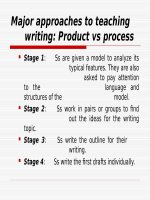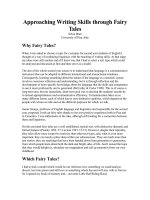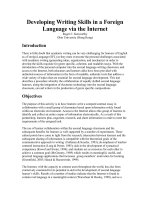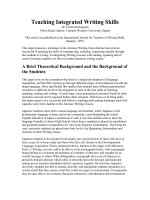Teaching writing skill
Bạn đang xem bản rút gọn của tài liệu. Xem và tải ngay bản đầy đủ của tài liệu tại đây (305.12 KB, 8 trang )
Major approaches to teaching
writing: Product vs process
Stage 1: Ss are given a model to analyze its
typical features. They are also
asked to pay attention to the
language and structures of the
model.
Stage 2: Ss work in pairs or groups to find
out the ideas for the writing topic.
Stage 3: Ss write the outline for their
writing.
Stage 4: Ss write the first drafts individually.
Major approaches to teaching
writing: Product vs process
Stage 5: Ss exchange their papers with
other Ss to get comments.
Stage 6: Ss get the paper back and write
another version, making any changes
basing on their friends’ feedback.
Stage 7: Ss may submit their writing to the
teacher for assessment.
Stage 8: T may correct one or two certain
writing papers. T reminds Ss of
common errors and the right use of
necessary structures as well as
vocabulary.
Types of writing activities
I/ Controlled writing
1. Purpose: for students at elementary level, this
can help students learn new words, structures.
2. Activities:
Substitution/ Transformation.
Gap-filling
Completing the sentences
Describing the pictures
Re-ordering words to make complete sentences
Using the cued words/phrases to make
sentences
Types of writing activities
ll. Guided writing (freer writing)
1. Purpose: Students move from controlled
exercises to freer paragraph writing. This is
quite a difficult task. However, Ss will make this
transition more easily and learn more if we
guide their writing.
2. There are two main ways of doing this:
By giving a short text as model.
By doing oral preparation for the writing. Ss
make suggestions, T builds up an outline or list
of key expressions on the board. The Ss often
use this as a basis for their writing.
Types of writing activities
lll/ Free writing
1. Characteristics:
•
no suggestion.
•
encourages Ss’ creativity and is often more
interesting to Ss.
•
errors and mistakes are unpredictable.
2. Types
•
Paragraph writing
•
Essay writing









